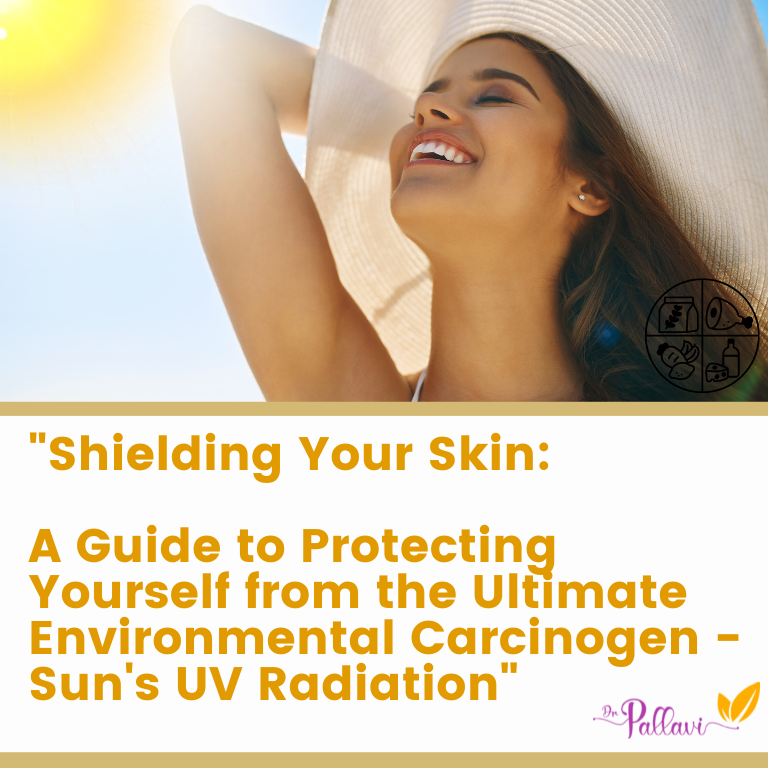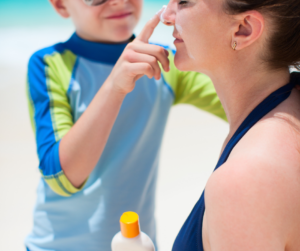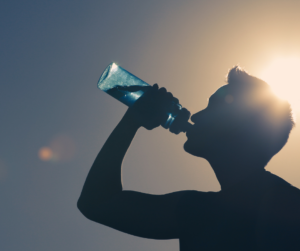
“Shielding Your Skin: A Guide to Protecting Yourself from the Ultimate Environmental Carcinogen – Sun’s UV Radiation”
Soaking up the sun and achieving a beautifully bronzed glow is a beloved activity for many people. It’s an opportunity to relax, unwind, and feel the warmth on your skin.
However, it’s important to remember the potential risks associated with overexposure to the sun’s harmful UV rays.
Exposure to the sun’s ultraviolet (UV) radiation is the leading cause of skin cancer, including Melanoma, the deadliest form of skin cancer.
UV radiation from the sun is a well-established environmental carcinogen & prolonged and repeated exposure to UV radiation can damage the DNA in skin cells, leading to mutations that can cause skin cancer.
Tanning is your skin’s natural response to UV radiation. When your skin is exposed to the sun’s UV rays, it produces more melanin to protect itself from the harmful effects of UV rays.

Even though a tan may make you look more attractive, the truth is that tanning is a sign that your skin has already been damaged, and it’s important to remember that even a slight tan can increase your risk of developing skin cancer.
Let’s understand how UV radiation can cause Skin Cancer:
When your skin is exposed to the sun’s UV radiation, it can penetrate the outer layers of your skin and then reach the deeper layers, including the DNA in your skin cells.
UV radiation can cause mutations in your skin cell’s DNA, leading to uncontrolled cell growth and, potentially, skin cancer.
UV radiation can damage DNA in a few different ways:
For example, it can cause two adjacent DNA molecules to bind together, forming what’s known as a dimer. These dimers can interfere with the normal functioning of the DNA, leading to mutations that can cause cancer.
Secondly, UV radiation can also cause oxidative stress in your skin cells, leading to DNA damage. When your skin is exposed to UV radiation, it can cause the production of reactive oxygen species (ROS) in your skin cells, which can damage your skin cells’ DNA and other cellular structures.
Skin cancer can develop when the DNA in your skin cells is damaged by exposure to sun ultraviolet (UV) radiation or other sources as well, such as tanning beds.

There are different types of skin cancers, including basal cell carcinoma, squamous cell carcinoma, and Melanoma.
Basal cell carcinoma and squamous cell carcinoma are the most common types of skin cancer and are often related to chronic exposure to the sun. Although considered precancerous, both are usually non-life-threatening and can be removed by a dermatologist.
However, Melanoma is a more severe type of skin cancer and can be life-threatening if not detected and treated early.
Exposure to UV radiation from the sun can also cause benign tumors called solar keratoses, which are ten times more common than skin cancers.
On the other hand, Melanoma is a malignant type of skin cancer that develops in the Melanocytes, the cells that produce pigment in the skin. It is considered more aggressive and potentially more deadly than BCC and SCC because it can spread quickly to other body parts. It often appears as an unusual-looking mole or lesion on the skin, and early detection and treatment are crucial for a good prognosis.
Studies have shown that populations with high ambient sun exposure and solar radiation transmission have higher skin cancer rates.
Also, prolonged sun exposure can lead to premature skin aging, including wrinkles, age spots, and dryness.
The bottom line is that even a slight tan can indicate skin damage and an increased risk of skin cancer. It’s essential to protect your skin from the sun’s harmful UV radiation to reduce your risk of skin cancer and still enjoy the outdoors safely.
Fortunately, by following a few simple steps, you can enjoy the great outdoors while minimizing your risk of skin damage and cancer.
Let’s take a closer look at each of these sun protection measures.
- Use sunscreen:
 Sunscreen is one of the most essential tools for protecting your skin from UV radiation. Make sure to choose a broad-spectrum sunscreen with an SPF of at least 30, protecting against UVA and UVB radiation. Apply a generous amount of sunscreen to all exposed skin, including your face, neck, and ears, at least 15 minutes before going outside. Reapply every two hours or more often if you are sweating or swimming.
Sunscreen is one of the most essential tools for protecting your skin from UV radiation. Make sure to choose a broad-spectrum sunscreen with an SPF of at least 30, protecting against UVA and UVB radiation. Apply a generous amount of sunscreen to all exposed skin, including your face, neck, and ears, at least 15 minutes before going outside. Reapply every two hours or more often if you are sweating or swimming. - Seek shade:
 When outdoors, seek shade to protect yourself from the sun’s harmful rays. This can include natural shade, such as under a tree or awning, or artificial shade, such as a beach umbrella or canopy. Be aware that some UV radiation can still reach your skin even when you’re in the shade, so it’s crucial to combine shade with other sun protection measures.
When outdoors, seek shade to protect yourself from the sun’s harmful rays. This can include natural shade, such as under a tree or awning, or artificial shade, such as a beach umbrella or canopy. Be aware that some UV radiation can still reach your skin even when you’re in the shade, so it’s crucial to combine shade with other sun protection measures. - Wear protective clothing:
 Clothing can be an effective barrier against UV radiation. Wear long-sleeved shirts, pants, and hats that cover your face, neck, and ears. Look for clothing made from tightly woven fabrics that provide more protection than loose weaves or knits. Some clothing is also designed with UPF (ultraviolet protection factor) ratings, which indicate how much UV radiation can penetrate the fabric.
Clothing can be an effective barrier against UV radiation. Wear long-sleeved shirts, pants, and hats that cover your face, neck, and ears. Look for clothing made from tightly woven fabrics that provide more protection than loose weaves or knits. Some clothing is also designed with UPF (ultraviolet protection factor) ratings, which indicate how much UV radiation can penetrate the fabric. - Avoid peak sun hours: The UV radiation is strongest between 10 a.m. and 4 p.m., so try to avoid being outdoors during these hours or take extra precautions to protect your skin. If you must be outside, seek shade, wear protective clothing, and use sunscreen.
- Stay hydrated and eat an antioxidant-rich diet –
 To protect your skin from the damaging effects of UV radiation, it’s essential to stay hydrated and eat a diet high in antioxidants, such as vitamins A, C, and E, especially if you are enjoying a sunny day out! Antioxidants work by neutralizing free radicals, reducing inflammation caused by UV radiation, and supporting the skin’s structure by promoting collagen production. Consuming a diet rich in antioxidant-containing foods and using skincare products that contain antioxidants can help protect your skin from sun damage and keep it healthy and youthful.
To protect your skin from the damaging effects of UV radiation, it’s essential to stay hydrated and eat a diet high in antioxidants, such as vitamins A, C, and E, especially if you are enjoying a sunny day out! Antioxidants work by neutralizing free radicals, reducing inflammation caused by UV radiation, and supporting the skin’s structure by promoting collagen production. Consuming a diet rich in antioxidant-containing foods and using skincare products that contain antioxidants can help protect your skin from sun damage and keep it healthy and youthful.
Also, regular skin checks are essential for maintaining good health and protecting yourself from skin cancer. Skin cancer is the most common type of cancer globally, and early detection is crucial for successful treatment. By regularly checking your skin and being aware of any changes, you can catch skin cancer early and improve your chances of recovery. It is essential to consult a dermatologist for a professional skin check, especially if you have a family history of skin cancer or have noticed any suspicious moles or lesions on your skin.
Let’s have a look at some facts related to this topic:
- Skin cancer is the most common type of cancer in the world. According to the Skin Cancer Foundation, one in five Americans will develop skin cancer by the age of 70. The most common types of skin cancer are basal cell carcinoma, squamous cell carcinoma, and melanoma.
- The damage caused by UV radiation from the sun can accumulate over time. This means that even if you only get a little bit of sun exposure each day, the damage can add up over time and increase your risk of developing skin cancer.
- Sunburns are a sign of skin damage. When your skin turns red and hurts after being in the sun, it means that your skin cells have been damaged by UV radiation. Sunburns increase your risk of developing skin cancer.
- Tanning, whether from the sun or a tanning bed, is also a sign of skin damage. When your skin tans, it means that it has been damaged by UV radiation. Tanning increases your risk of developing skin cancer, even if you don’t burn.
- Sun damage can occur even on cloudy days. Although it may not be as obvious, UV radiation from the sun can penetrate through clouds and still cause skin damage. It’s important to wear sunscreen and protect your skin even on cloudy days.
To summarise today’s blog : Protecting your skin from the sun’s harmful UV radiation is essential in reducing your risk of skin damage and skin cancer, including Melanoma.

Even a slight tan can be a sign of skin damage, and repeated exposure to UV radiation can increase your risk of developing skin cancer over time. However, by following some simple steps, you can still enjoy the outdoors while minimizing the risk. These steps include using sunscreen with an SPF of at least 30, seeking shade, wearing protective clothing, avoiding peak sun hours, staying hydrated & eating an antioxidant-rich diet.
It’s important to prioritize sun protection and make it a part of your regular routine to keep your skin healthy and reduce your risk of skin cancer.
Thank you for reading today’s blog!
If you found it informative and helpful, please consider liking and sharing it with others who may benefit from this information. Also, make sure to subscribe to my blog for more updates and insights on holistic health and wellness.
If you are struggling with any chronic skin issue, I am here to help you. As a holistic practitioner, I offer a natural and comprehensive approach to healing, focused on improving your overall health and strengthening your immune system.
If you are interested in learning more, I invite you to schedule a discovery consultation with me by emailing contact@holisticskinwellness.com. Together, we can create a personalized plan to help you achieve healthy, clear skin!
